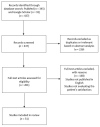Patient Satisfaction with Telemedicine during the COVID-19 Pandemic-A Systematic Review
- PMID: 35627650
- PMCID: PMC9140408
- DOI: 10.3390/ijerph19106113
Patient Satisfaction with Telemedicine during the COVID-19 Pandemic-A Systematic Review
Abstract
Telemedicine is a convenient tool for providing medical care remotely. It is routinely offered as an alternative to face-to-face consultations in healthcare settings all over the world. Due to the COVID-19 pandemic and increased use of telemedicine in everyday clinical practice, the effectiveness of this modality and patient satisfaction with telemedicine is a subject of growing concern. PubMed and Google Scholar databases were searched. Papers published between January 2020 and August 2021 which met inclusion and exclusion criteria were analyzed. During the COVID-19 pandemic patients have found telemedicine a beneficial tool for consulting healthcare providers. A high level of satisfaction with telehealth was observed in each study across every medical specialty. Telemedicine is undoubtedly a convenient tool that has helped ensure continuity of medical care during the COVID-19 pandemic thanks to its considerable potential. In particular situations, telehealth may adequately replace face-to-face consultation. Regular patients' feedback is necessary to improve the use of telemedicine in the future.
Keywords: patient satisfaction; telehealth; telemedicine.
Conflict of interest statement
The authors declare no conflict of interest.
Figures
References
-
- Hammersley V., Donaghy E., Parker R., McNeilly H., Atherton H., Bikker A., Campbell J., McKinstry B. Comparing the content and quality of video, telephone, and face-to-face consultations: A non-randomised, quasi-experimental, exploratory study in UK primary care. Br. J. Gen. Pract. 2019;69:e595–e604. doi: 10.3399/bjgp19X704573. - DOI - PMC - PubMed
-
- World Health Organization Weekly Epidemiological Update on COVID-19 [Internet]. 2021 August. [(accessed on 16 August 2021)]. Available online: https://www.who.int/publications/m/item/weekly-epidemiological-update-on....
Publication types
MeSH terms
LinkOut - more resources
Full Text Sources
Medical
Miscellaneous


